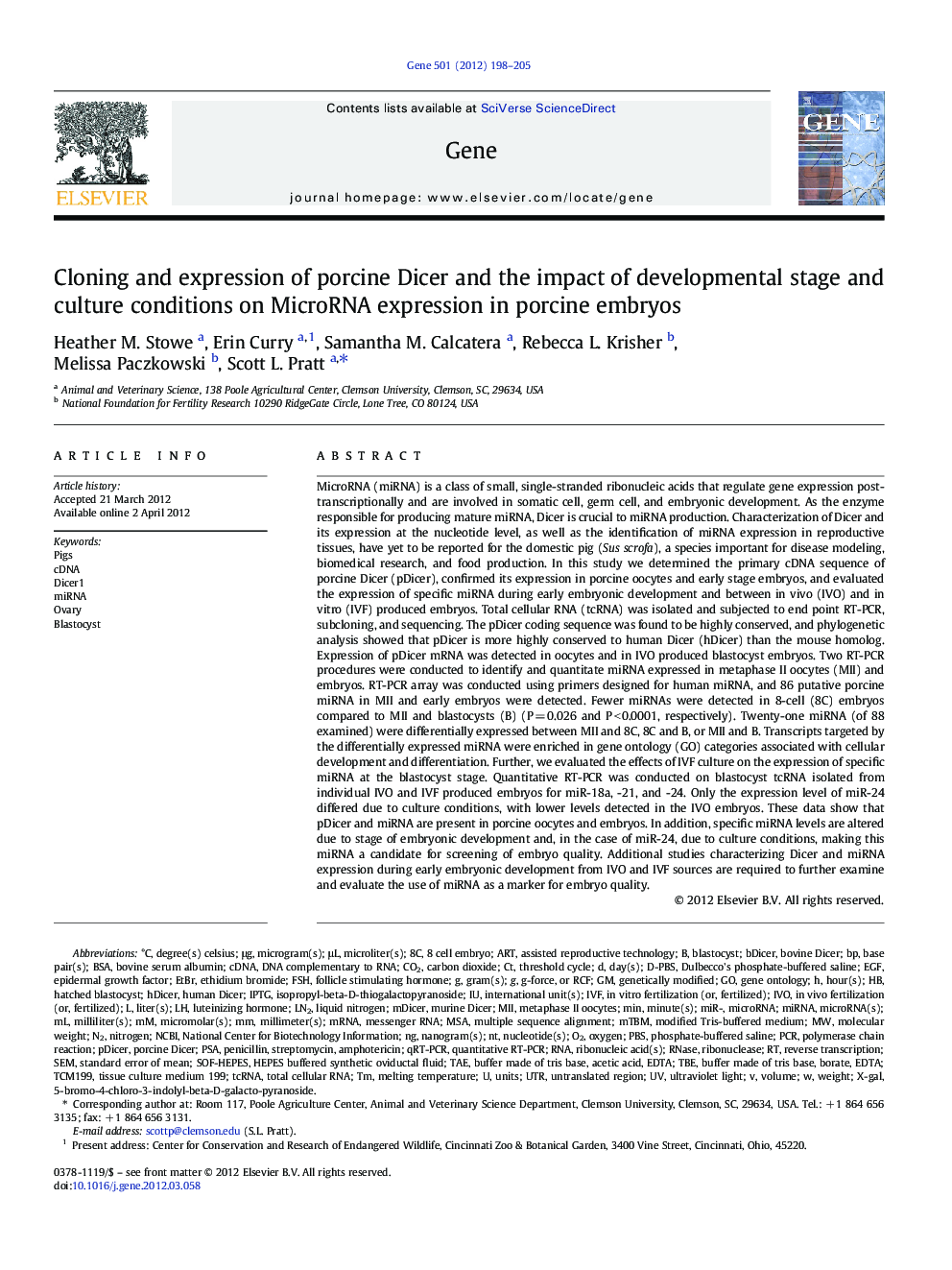| کد مقاله | کد نشریه | سال انتشار | مقاله انگلیسی | نسخه تمام متن |
|---|---|---|---|---|
| 2817869 | 1160015 | 2012 | 8 صفحه PDF | دانلود رایگان |

MicroRNA (miRNA) is a class of small, single-stranded ribonucleic acids that regulate gene expression post-transcriptionally and are involved in somatic cell, germ cell, and embryonic development. As the enzyme responsible for producing mature miRNA, Dicer is crucial to miRNA production. Characterization of Dicer and its expression at the nucleotide level, as well as the identification of miRNA expression in reproductive tissues, have yet to be reported for the domestic pig (Sus scrofa), a species important for disease modeling, biomedical research, and food production. In this study we determined the primary cDNA sequence of porcine Dicer (pDicer), confirmed its expression in porcine oocytes and early stage embryos, and evaluated the expression of specific miRNA during early embryonic development and between in vivo (IVO) and in vitro (IVF) produced embryos. Total cellular RNA (tcRNA) was isolated and subjected to end point RT-PCR, subcloning, and sequencing. The pDicer coding sequence was found to be highly conserved, and phylogenetic analysis showed that pDicer is more highly conserved to human Dicer (hDicer) than the mouse homolog. Expression of pDicer mRNA was detected in oocytes and in IVO produced blastocyst embryos. Two RT-PCR procedures were conducted to identify and quantitate miRNA expressed in metaphase II oocytes (MII) and embryos. RT-PCR array was conducted using primers designed for human miRNA, and 86 putative porcine miRNA in MII and early embryos were detected. Fewer miRNAs were detected in 8-cell (8C) embryos compared to MII and blastocysts (B) (P = 0.026 and P < 0.0001, respectively). Twenty-one miRNA (of 88 examined) were differentially expressed between MII and 8C, 8C and B, or MII and B. Transcripts targeted by the differentially expressed miRNA were enriched in gene ontology (GO) categories associated with cellular development and differentiation. Further, we evaluated the effects of IVF culture on the expression of specific miRNA at the blastocyst stage. Quantitative RT-PCR was conducted on blastocyst tcRNA isolated from individual IVO and IVF produced embryos for miR-18a, -21, and -24. Only the expression level of miR-24 differed due to culture conditions, with lower levels detected in the IVO embryos. These data show that pDicer and miRNA are present in porcine oocytes and embryos. In addition, specific miRNA levels are altered due to stage of embryonic development and, in the case of miR-24, due to culture conditions, making this miRNA a candidate for screening of embryo quality. Additional studies characterizing Dicer and miRNA expression during early embryonic development from IVO and IVF sources are required to further examine and evaluate the use of miRNA as a marker for embryo quality.
► Porcine Dicer is more highly conserved to humans than mouse Dicer is to humans.
► Porcine Dicer mRNA is present in oocytes and in vivo produced blastocyst embryos.
► Eighty-six miRNA were detected in pig oocytes, 8-cell embryos, and blastocysts.
► Fewer miRNA are expressed at 8-cell than in oocytes and blastocyst.
► Expression levels of miR-24 are lower in in vivo produced embryos than in vitro.
Journal: Gene - Volume 501, Issue 2, 15 June 2012, Pages 198–205